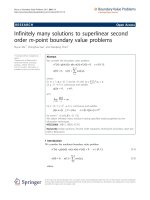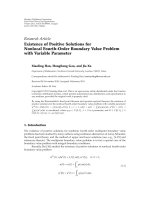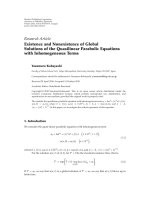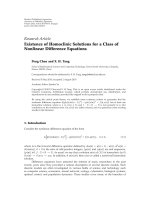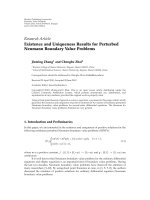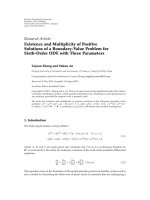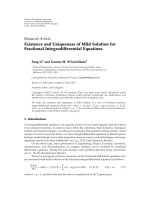báo cáo hóa học:" Research Article Existence and Uniqueness Results for Perturbed Neumann Boundary Value Problems" potx
Bạn đang xem bản rút gọn của tài liệu. Xem và tải ngay bản đầy đủ của tài liệu tại đây (483.09 KB, 10 trang )
Hindawi Publishing Corporation
Boundary Value Problems
Volume 2010, Article ID 494210, 10 pages
doi:10.1155/2010/494210
Research Article
Existence and Uniqueness Results for Perturbed
Neumann Boundary Value Problems
Jieming Zhang
1
and Chengbo Zhai
2
1
Business College of Shanxi Universit, Taiyuan, Shanxi 030031, China
2
School of Mathematical Sciences, Shanxi University, Taiyuan, Shanxi 030006, China
Correspondence should be addressed to Chengbo Zhai,
Received 20 April 2010; Accepted 28 June 2010
Academic Editor: Irena Rach
˚
unkov
´
a
Copyright q 2010 J. Zhang and C. Zhai. This is an open access article distributed under the
Creative Commons Attribution License, which permits unrestricted use, distribution, and
reproduction in any medium, provided the original work is properly cited.
Using a fixed point theorem of general α-concave operators, we present in this paper criteria which
guarantee the existence and uniqueness of positive solutions for two classes of nonlinear perturbed
Neumann boundary value problems for second-order differential equations. The theorems for
Neumann boundary value problems obtained are very general.
1. Introduction and Preliminaries
In this paper, we are interested in the existence and uniqueness of positive solutions for the
following nonlinear perturbed Neumann boundary value problems NBVPs:
P
±
⎧
⎨
⎩
±u
t
m
2
u
t
f
t, u
t
g
t
, 0 <t<1,
u
0
u
1
0,
1.1
where m is a positive constant, f : 0, 1 × 0, ∞ → 0, ∞ and g : 0, 1 → 0, ∞ are
continuous.
It is well known that Neumann boundary value problem for the ordinary differential
equations and elliptic equations is an important kind of boundary value problems. During
the last two decades, Neumann boundary value problems have deserved the attention of
many researchers 1–10. By using-fixed point theorems in cone, in 1, 5, 7–9, the authors
discussed the existence of positive solutions for ordinary differential equation Neumann
boundary value problems.
2 Boundary Value Problems
Recently, the authors 4 discussed second-order superlinear repulsive singular
Neumann boundary value problems by using a nonlinear alternative of Leray-Schauder and
Krasnosel’skii fixed-point theorem on compression and expansion of cones, and obtained the
existence of at least two positive solutions under reasonable conditions. In 6, the authors
established the existence of sign-changing solutions and positive solutions f or fourth-order
Neumann boundary value problem by using the fixed-point index and the critical group.
Besides the above methods mentioned, the method of upper and lower solutions is also used
in the literature 2, 3, 10. However, to the best of our knowledge, few papers can be found
in the literature on the existence and uniqueness of positive solutions for the NBVPs P
±
.
Different from the above works mentioned, in this paper, we will use a fixed-point theorem
of general α-concave operators to show the existence and uniqueness of positive solutions for
the NBVPs P
±
.
By a positive solution of P
±
, we understand a function ut ∈ C
2
0, 1 which is
positive on 0 <t<1 and satisfies the differential equation and the boundary conditions
in P
±
.
We now present a fixed point theorem of general α-concave operators which will be
used in the latter proofs. Let E be a real Banach space and P be a cone in E, θ denotes the null
element. Given h>θi.e., h ≥ θ and h
/
θ, we denote by P
h
the set
P
h
x ∈ P |∃λ
x
,μ
x
> 0 such that λ
x
h ≤ x ≤ μ
x
h
. 1.2
See 11 for further information.
Theorem 1.1 see 11. Assume that cone P is normal and operator A satisfies the following
conditions:
B
1
A : P
h
→ P
h
is increasing in P
h
,
B
2
for for all x ∈ P
h
and t ∈ 0, 1, there exists αt ∈ 0, 1 such that Atx ≥ t
αt
Ax,
B
3
there is a constant l ≥ 0 such that x
0
∈ θ, lh.
Then operator equation x Ax x
0
has a unique solution in P
h
.
Remark 1.2. An operator A is said to be general α-concave if A satisfies condition B
2
.
2. Positive Solutions for the Problems P
±
In this section, we will apply Theorem 1.1 to study the general NBVPs P
±
and then we will
obtain new results on the existence and uniqueness of positive solutions for the problems
P
±
. The following conditions will be assumed:
H
1
ft, x is increasing in x for fixed t,
H
2
for any γ ∈ 0, 1 and x ≥ 0, there exists ϕγ ∈ γ,1 such that ft, γx ≥
ϕγft, x for t ∈ 0, 1,
H
3
for any t ∈ 0, 1,ft, a > 0, where a 1/2ch m 1.
In the following, we will work in the Banach space C0, 1 and only the sup-norm is
used. Set P {x ∈ C0, 1 | xt ≥ 0,t ∈ 0, 1}, the standard cone. It is easy to see that P is
Boundary Value Problems 3
a normal cone of which the normality constant is 1. Let Gt, s be the Green’s function for the
boundary value problem
−u
t
m
2
u
t
0, 0 <t<1,
u
0
u
1
0.
2.1
Then,
G
t, s
1
ρ
⎧
⎨
⎩
ψ
s
ψ
1 − t
, 0 ≤ s ≤ t ≤ 1,
ψ
t
ψ
1 − s
, 0 ≤ t ≤ s ≤ 1,
2.2
where ρ m · sh m, ψtch mt. It is obvious that ψt is increasing on 0, 1,and
0 <G
t, s
≤ G
t, t
, 0 ≤ t, s ≤ 1. 2.3
Lemma 2.1 see 9. Let Gt, s
be the Green’s function for the NBVP 2.1. then,
G
t, s
≥
1
ch
2
m
ch mt · ch
1 − t
m · G
t
0
,s
,t,t
0
,s∈
0, 1
.
2.4
Theorem 2.2. Assume H
1
− H
3
hold. Then the NBVP P
−
has a unique positive solution u
∗
in
P
h
, where htψtψ1 − t1/2ch m chm − 2mt,t∈ 0, 1.
Remark 2.3. Let b 1/2e
m
e
−m
. Then it is easy to check that a min{ht : t ∈ 0, 1}
1/2ch m 1,b max{ht : t ∈ 0, 1} chm.
Proof of Theorem 2.2. It is well known that u is a solution of the NBVP P
−
if and only if
u
t
1
0
G
t, s
f
s, u
s
g
s
ds,
2.5
where Gt, s is the Green’s function for the NBVP 2.1. For any u ∈ P, we define
Au
t
1
0
G
t, s
f
s, u
s
ds, x
0
t
1
0
G
t, s
g
s
ds.
2.6
It is easy to check that A : P → P. From H
1
, we know that A : P → P is an increasing
operator. Next we show that A satisfies the conditions B
1
, B
2
in Theorem 1.1.FromH
2
,
for any γ ∈ 0, 1 and u ∈ P, there exists ϕγ ∈ γ,1 such that
A
γu
t
1
0
G
t, s
f
s, γu
s
ds ≥
1
0
G
t, s
ϕ
γ
f
s, u
s
ds ϕ
γ
Au
t
,t∈
0, 1
.
2.7
4 Boundary Value Problems
That is, Aγu ≥ ϕγAu, for all u ∈ P, γ ∈ 0, 1. Set
α
γ
ln ϕ
γ
ln γ
,
2.8
then αγ ∈ 0, 1 and
A
γu
≥ γ
αγ
Au, for γ ∈
0, 1
,u∈ P.
2.9
In the following, we show that A : P
h
→ P
h
. On one hand, it follows from H
1
, H
3
,
Lemma 2.1 and Remark 2.3,that
Ah
t
1
0
G
t, s
f
s, h
s
ds
≥
1
0
1
ch
2
m
ψ
t
ψ
1 − t
G
t
0
,s
f
s, a
ds
1
ch
2
m
h
t
1
0
G
t
0
,s
f
s, a
ds, t ∈
0, 1
.
2.10
On the other hand, from 2.3, H
1
,andRemark 2.3,weobtain
Ah
t
1
0
G
t, s
f
s, h
s
ds
≤
1
0
G
t, t
f
s, b
ds
1
ρ
h
t
1
0
f
s, b
ds, t ∈
0, 1
.
2.11
Let
r
1
min
t∈
0,1
f
t, a
,r
2
max
t∈0,1
f
t, b
.
2.12
Then 0 <r
1
≤ r
2
. Note that
1
0
G
t
0
,s
ds
1
ρ
t
0
0
ψ
s
ψ
1 − t
0
ds
1
ρ
1
t
0
ψ
t
0
ψ
1 − s
ds
1
m
2
.
2.13
Consequently,
r
1
ch
2
m
·
1
m
2
h
t
≤ Ah
t
≤ r
2
·
1
mshm
h
t
,t∈
0, 1
.
2.14
Boundary Value Problems 5
Hence Ah ∈ P
h
. For any u ∈ P
h
, we can choose a small number t
0
∈ 0, 1 such that
t
0
h ≤ u ≤
1
t
0
h.
2.15
By 2.9,weget
A
1
γ
u
≤
1
γ
αγ
Au, ∀γ ∈
0, 1
,u∈ P.
2.16
Thus, from 2.9, 2.16, we have
Au ≥ A
t
0
h
≥ t
0
αt
0
Ah, Au ≤ A
1
t
0
h
≤
1
t
0
αt
0
Ah.
2.17
Thus, Au ∈ P
h
. Therefore, A : P
h
→ P
h
. This together with 2.9 implies t hat A is general
α-concave. That is, A satisfies the conditions B
1
, B
2
in Theorem 1.1.
Next we show that the condition B
3
is satisfied. If gt ≡ 0, then x
0
t ≡ 0; if gt
/
≡ 0,
let l ρ max
t∈0,1
gt, then l>0. It is easy to prove that
0 ≤ x
0
t
≤
l
ρ
1
0
G
t, t
ds lh
t
.
2.18
Hence, 0 ≤ x
0
≤ lh. Finally, using Theorem 1.1, u Au x
0
has a unique solution u
∗
in P
h
.
That is, u
∗
is a unique positive solution of the NBVP P
−
in P
h
.
In the following, using the same technique, we study the general NBVP P
with
m ∈ 0,π/2. Let Gt, s be the Green’s function for the boundary value problem
u
t
m
2
u
t
0, 0 <t<1,
u
0
u
1
0.
2.19
Then,
G
t, s
1
m sin m
⎧
⎨
⎩
cos ms cos m
1 − t
, 0 ≤ s ≤ t ≤ 1,
cos mt cos m
1 − s
, 0 ≤ t ≤ s ≤ 1.
2.20
It is obvious that cos mt is decreasing on 0, 1,and
G
t, s
≥ G
t, t
, 0 ≤ t, s ≤ 1. 2.21
Lemma 2.4. Let Gt, s be the Green’s function for the NBVP 2.19. Then,
G
t, s
≤
1
cos
2
m
cos mt cos m
1 − t
· G
t
0
,s
,t,t
0
,s∈
0, 1
.
2.22
6 Boundary Value Problems
Proof. When t, t
0
≤ s,
G
t, s
G
t
0
,s
cos m
1 − s
cos mt
cos m
1 − s
cos mt
0
cos m
1 − t
cos mt
cos m
1 − t
cos mt
0
≤
1
cos
2
m
cos m
1 − t
cos mt C cos m
1 − t
cos mt.
2.23
If t ≤ s ≤ t
0
,
G
t, s
G
t
0
,s
cos m
1 − s
cos mt
cos m
1 − t
0
cos ms
cos m
1 − t
cos mt
cos m
1 − t
cos ms
·
cos m
1 − s
cos m
1 − t
0
≤
1
cos
2
m
cos m
1 − t
cos mt C cos m
1 − t
cos mt.
2.24
If t
0
≤ s ≤ t,
G
t, s
G
t
0
,s
cos m
1 − t
cos ms
cos m
1 − s
cos mt
0
cos m
1 − t
cos mt
cos m
1 − s
cos mt
·
cos ms
cos mt
0
≤
1
cos
2
m
cos m
1 − t
cos mt C cos m
1 − t
cos mt.
2.25
For s ≤ t, t
0
,
G
t, s
G
t
0
,s
cos m
1 − t
cos ms
cos m
1 − t
0
cos ms
cos m
1 − t
cos mt
cos m
1 − t
0
cos mt
≤
1
cos
2
m
cos m
1 − t
cos mt C cos m
1 − t
cos mt.
2.26
Therefore,
G
t, s
≤
1
cos
2
m
cos m
1 − t
cos mt · G
t
0
,s
,t,t
0
,s∈
0, 1
.
2.27
This completes the proof.
Theorem 2.5. Assume H
1
, H
2
hold and ft, cos
2
m > 0 for any t ∈ 0, 1. Then the NBVPP
has a unique positive solution u
∗
in P
h
, where htcos m1 − t cos mt, t ∈ 0, 1.
Remark 2.6. It is easy to check that cos
2
m ≤ ht ≤ 1fort ∈ 0, 1.
Proof of Theorem 2.5. It is well known that u is a solution of the NBVP P
if and only if
u
t
1
0
G
t, s
f
s, u
s
g
s
ds,
2.28
Boundary Value Problems 7
where Gt, s is the Green’s function for the NBVP 2.19. For any u ∈ P, we define
Au
t
1
0
G
t, s
f
s, u
s
ds, x
0
t
1
0
G
t, s
g
s
ds.
2.29
Similar to the proof of Theorem 2.2, we know that A : P → P is an increasing operator and
satisfies the condition
A
γu
≥ ϕ
γ
Au γ
αγ
Au, ∀u ∈ P, γ ∈
0, 1
,
2.30
where αγln ϕγ/ ln γ.
It follows from condition H
1
, Lemma 2.4,andRemark 2.6 that
Ah
t
1
0
G
t, s
f
s, h
s
ds
≤
1
0
1
cos
2
m
cos mt cos m
1 − t
· G
t
0
,s
f
s, 1
ds
1
cos
2
m
h
t
1
0
G
t
0
,s
f
s, 1
ds, t ∈
0, 1
.
2.31
From 2.21, H
1
,andRemark 2.6,weobtain
Ah
t
1
0
G
t, s
f
s, h
s
ds
≥
1
0
G
t, t
f
s, cos
2
m
ds
1
m sin m
h
t
1
0
f
s, cos
2
m
ds, t ∈
0, 1
.
2.32
Let
r
1
min
t∈
0,1
f
t, cos
2
m
,r
2
max
t∈0,1
f
t, 1
.
2.33
Then 0 <r
1
≤ r
2
. Consequently,
Ah
t
≤ r
2
1
cos
2
m
1
0
G
t
0
,s
ds · h
t
,Ah
t
≥ r
1
1
m sin m
h
t
,t∈
0, 1
.
2.34
8 Boundary Value Problems
Note that
1
0
G
t
0
,s
ds
1
m sin m
t
0
0
cos m
1−t
0
cos msds
1
m sin m
1
t
0
cos m
1−s
cos mt
0
ds
1
m
2
,
2.35
we have r
2
1/cos
2
m
1
0
Gt
0
,sds > 0. Hence Ah ∈ P
h
. The same reasoning as Theorem 2.2
shows that A is general α-concave and B
3
is satisfied. Using Theorem 1.1, u Au x
0
has a
unique solution u
∗
in P
h
.Thatis,u
∗
is a unique positive solution of the NBVP P
in P
h
.
Remark 2.7. For the case of gt ≡ 0, the problems P
±
reduce to the usual forms of Neumann
boundary value problems for ordinary differential equations. We can establish the existence
and uniqueness of positive solutions for these problems by using the same method used in
this paper, which is new to the literature. So the method used in this paper is different from
previous ones in literature and the results obtained in this paper are new.
3. Examples
To illustrate how our main results can be used in practice we present two examples.
Example 3.1. Consider the following NBVP:
−u
t
ln 2
2
u
t
u
β
t
q
t
t
2
, 0 <t<1,
u
0
u
1
0,
3.1
where β ∈ 0, 1 and q : 0, 1 → 0, ∞ is a continuous function. In this example, we let
m ln 2,ft, x : x
β
qt,gt : t
2
. After a simple calculation, we get a 9/8,b 5/4and
h
t
5
8
1
4
2
1−2t
2
2t−1
,t∈
0, 1
.
3.2
Evidently, ft, x is increasing for x ≥ 0, and gt
/
≡ 0,
f
t, a
9
8
β
q
t
> 0.
3.3
Moreover, set ϕγγ
β
,γ ∈ 0, 1. Then,
f
t, γx
γ
β
x
β
q
t
≥ γ
β
x
β
q
t
ϕ
γ
f
t, x
,x≥ 0. 3.4
Hence, all the conditions of Theorem 2.2 are satisfied. An application of Theorem 2.2 implies
that the NBVP 3.1 has a unique positive solution u
∗
in P
h
.
Boundary Value Problems 9
Example 3.2. Consider the following NBVP:
u
t
π
3
2
u
t
u
1/3
t
q
t
t
3
, 0 <t<1,
u
0
u
1
0,
3.5
where q : 0, 1 → 0, ∞ is a continuous function. In this example, we let m π/3,ft, x :
x
1/3
qt,gt : t
3
. Then, m ∈ 0,π/2 and
h
t
cos
π
3
t cos
π
3
1 − t
,t∈
0, 1
.
3.6
Evidently, ft, x is increasing for x ≥ 0, and gt
/
≡ 0,
f
t, cos
2
π
3
q
t
1
4
1/3
q
t
> 0.
3.7
Moreover, set ϕγγ
1/3
,γ ∈ 0, 1. Then,
f
t, γx
γ
1/3
x
1/3
q
t
≥ γ
1/3
x
1/3
q
t
ϕ
γ
f
t, x
,x≥ 0. 3.8
Hence, all the conditions of Theorem 2.5 are satisfied. An application of Theorem 2.5 implies
that the NBVP 3.5 has a unique positive solution u
∗
in P
h
.
Acknowledgment
Research was supported by the Youth Science Foundation of Shanxi Province 2010021002-1.
References
1 A. Bensedik and M. Bouchekif, “Symmetry and uniqueness of positive solutions for a Neumann
boundary value problem,” Applied Mathematics Letters, vol. 20, no. 4, pp. 419–426, 2007.
2 A. Cabada and R. L. Pouso, “Existence result for the problem ϕu
ft, u, u
with periodic and
Neumann boundary conditions,” Nonlinear Analysis: Theory, Methods & Applications, vol. 30, no. 3, pp.
1733–1742, 1997.
3 A. Cabada and L. Sanchez, “A positive operator approach to the Neumann problem for a second
order ordinary differential equation,” Journal of Mathematical Analysis and Applications, vol. 204, no. 3,
pp. 774–785, 1996.
4 J. Chu, X. Lin, D. Jiang, D. O’Regan, and R. P. Agarwal, “Positive solutions for second-order
superlinear repulsive singular Neumann boundary value problems,” Positivity,vol.12,no.3,pp.
555–569, 2008.
5 D Q. Jiang and H Z. Liu, “Existence of positive solutions to second order Neumann boundary value
problems,” Journal of Mathematical Research and Exposition, vol. 20, no. 3, pp. 360–364, 2000.
6 F. Li, Y. Zhang, and Y. Li, “Sign-changing solutions on a kind of fourth-order Neumann boundary
value problem,” Journal of Mathematical Analysis and Applications, vol. 344, no. 1, pp. 417–428, 2008.
7 J P. Sun and W T. Li, “Multiple positive solutions to second-order Neumann boundary value
problems,” Applied Mathematics and Computation, vol. 146, no. 1, pp. 187–194, 2003.
10 Boundary Value Problems
8 J P. Sun, W T. Li, and S. S. Cheng, “Three positive solutions for second-order Neumann b oundary
value problems,” Applied Mathematics Letters, vol. 17, no. 9, pp. 1079–1084, 2004.
9 Y P. Sun and Y. Sun, “Positive solutions for singular semi-positone Neumann boundary-value
problems,” Electronic Journal of Differential Equations, vol. 2004, no. 133, pp. 1–8, 2004.
10 N. Yazidi, “Monotone method for singular Neumann problem,” Nonlinear Analysis: Theory, Methods &
Applications, vol. 49, no. 5, pp. 589–602, 2002.
11 C B. Zhai, C. Yang, and C M. Guo, “Positive solutions of operator equations on ordered Banach
spaces and applications,” Computers & Mathematics with Applications, vol. 56, no. 12, pp. 3150–3156,
2008.
